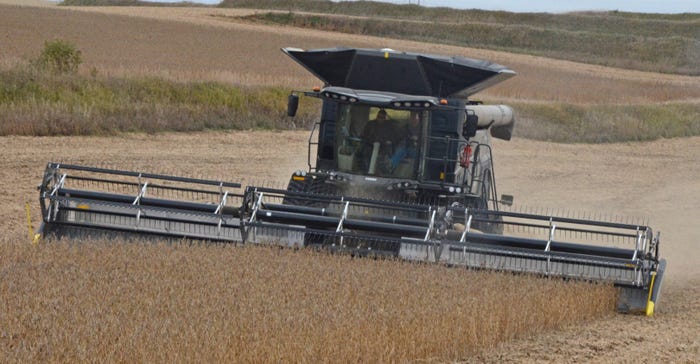
It's a cloudy October day in northwest Iowa. But there's no rain, no snow and only a slight breeze — an otherwise "ideal" day for harvest. Among the red and green machines traversing fields north of Sioux City, three black combines harvest soybeans in a farm field near Hinton.
The black Fendt Ideal combines are part of a limited launch for 2019. Agco officially launched the Class 7, 8 and 9 Ideal combines in North America in 2018. Conor Bergin, brand manager for North America at Agco, notes the initial launch for 2019 is being limited to 20 dealers in North America.
"We want to ensure our dealers, and ultimately our customers, have a positive experience with these machines," Bergin says. "Really, we want to ensure these machines are working properly, that we address any issues out of the gate. And we've been able to do that through a limited release."
In this year's limited run, Ideal combines have harvested a range of crops, including corn, wheat, canola, sorghum, lentils, and in Iowa, soybeans.
Touted as the industry's first "clean sheet" design combine in 30 years, Bergin notes the Ideal was designed based on several years of producer input, as well as engineering expertise from Agco. A big part of this "clean sheet" design is the ability to adapt to different crops and harvest conditions.
And with this year's narrow harvest window, Bergin says the Ideal's 485-bushel grain tank capacity and fast unload rate at 6 bushels per second have been an asset.
"Think about the short window of time we have, and the expense," Bergin says. "You've got grain carts; you've got semis. Everything's linked together in this harvest process. The quicker our growers can get grain off the machine, the quicker they can get through harvest. With that faster unload rate, it ensures the entire operation is continuing to move, continuing to be productive."
It's been a wet year overall, including this fall. Available with 26-, 30- and 36-inch tracks, Bergin says the Ideal's optional TrakRide system provides a comfortable ride, with greater weight distribution, less compaction and the ability to traverse wetter fields.
"We're seeing some really high-yielding soybeans — we're talking 60- to hopefully 80-bushel soybeans," Bergin says. "With the wetter conditions we've had this year, with high-yielding beans, green stem soybeans and overall tougher threshing conditions, the high capacity of this machine — the ability to adapt to wet or dry conditions and be gentle on the crop and not put any loss out of the back of the machine — has been very well received in this part of the country."
A big factor in adaptability is the Ideal's dual helix rotor design.
"It's just over 16 feet long," Bergin says. "It's actually the longest rotor design in the industry, and that's beneficial for a couple of reasons. That long rotor design allows us to spread the crop mat out and provides greater area for threshing and separation. As a result, we can run our rotors at a lower speed, because we've got more time, more space to thresh and separate the crop. That makes it easier on the machine, less fuel consumption, but it's also a lot gentler on the crop. So, we get a better sample, less cracks, less pods, less MOG, material other than grain, in the tank."
The Ideal Balance system is another piece of the puzzle, Bergin adds. This involves two specially molded grain pans to collect crop material from the threshing and separating area and distribute the crop evenly over the cleaning shoe.
With the Ideal Harvest system, the machine also self-adjusts for different conditions and crop types. This includes automated adjustments to rotor speed and fan speed as needed. The combine does this through about 24 mass acoustic detection sensors, which also allow the operator to monitor grain throughout the threshing and separating process, giving a good picture of the grain sample.
Rick Sparks, Agco product specialist, says on the hilly terrain of northwest Iowa, that's a handy tool to have. Ideal Harvest automatically decreases fan speed going uphill to prevent grain loss out of the back, and increases it going downhill to keep grain from overfilling.
"If we can understand the degree of slope, how that affects the flow through the combine, with Ideal Harvest, it actually will change the combine settings to allow for slopes up and down the hills, so we're not kicking it out over the back end or keeping the combine too full," Sparks says. "When you drive [a car] through a mountain pass, you have steep grades — usually a 6%, 7% or 8% grade. Here [in northwest Iowa] we are harvesting some 10-percent-plus grade hills and getting less than a quarter-bushel loss with the combine going up and down the hills."
"Our grain loss is very minimal," Sparks adds. "We're less than a quarter-bushel, typically. We're even seeing down to an eighth of a bushel or less. The machine has handled these conditions very well."
About the Author(s)
You May Also Like






